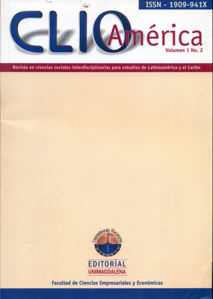El Sistema de patentes en Colombia
Contenido principal del artículo
Resumen
Descargas
Detalles del artículo
Esta revista proporciona un acceso abierto a su contenido, basado en el principio de ofrecer al público un acceso libre a las investigaciones ayuda a un mayor intercambio global del conocimiento. De igual forma su versión impresa es de libre acceso y no tiene costos asociados por publicación.
Citas
BASBERG, B. L. (1987). Patents and the Measurement of Technological Change: A Survey of the Literature. Research Policy 16: 131-141.
BESSEN, J and E. Maskin (2000). Sequential Innovation, Patent, and Imitation, MassaChusettts Institute of Technology.
BOLDRIN, M and D. Levine (2002). The Case Against Intellectual Property. University Of Minnesota and UCLA.
CAMPOS, N and Y. Kinoshita. (2002). Foreign Direct Investment as Technology TransFerred: Some Panel Evidence form the Transition Economies, William Davidson Working Paper Number 438.
CAVALIER, Abogados (2002) Compilación histórica de las Leyes colombianas sobre propiedad industrial: expedida desde 1823 hasta 1971.
CONNOLLY, Michelle (1999), North-South Technological Diffusion: a new case for dynamic gains from trade. No 99-08, Duke University.
DAVID, Paul (1996) Rethinking Technology Transfer CEPR publication No 478, Stanford University.
GINARTE, J. R and W. PARK (1997) Determinants of Patent Rights: A Cross-National Study. Research Policy, Vol. 26, pp. 283-301
GREEN, J. R and S. Scotchmer. 1995. ‘On the Division of Profit in Sequential Innovation’. The RAND Journal of Economic, Vol 26, Issue 1, pp 20-33
GRILICHES, Z. (1990). Patent Statistics as Economic Indicators: A Survey. Journal of Economic Literature XXVIII: 1661-1707. Citado por VERSPAGEN, B and W. Schoenmakers. 2002. ‘The Spatial Dimension of patenting by Multinational Firms in Europe. ECIS, MERIT
KAUFER, E. (1989). The Economics of the Patent System. Harwood Academic Publshed
KLEMPERER, Paul (1990). How broad should the scope patent protection be?, RAND Journal of Economic, Vol 21, No 1.
LERNER, Joshua, 150 Years of Patent Protection (January 2000). NBER Working Paper Nro. W7478.
LESSER, W. (2002). ‘The Effects of Intellectual Property Rights on Foreign Direct Invesment and Imports into Developing Countries in the Post TRIPs Era’. Biodevelopments International Institute.
MANSFIELD, Edwin (1994), Intellectual Property Protection, Foreign Direct Investment, and Technology Transfer. International Finance Corporation, Discussion Paper 19.
MASKUS, Keith. 1997. Intellectual Property Rights, Foreign Direct Investment, Direct investment, and Competition Issues in Developing Countries. CIES policy discussion paper.
NORDHAUS, W. (1972). The Optimum Life of a Patent: Reply. Cowles Foundation. American Economic Review,62.
O’DONOGHUE, Ted, (1997) A Patentability Requirement for Sequential Innovation. Northwestern University
O’DONOGHUE, T. S. SCOTCHMER, and J. THISSE. (1998) Patent Breadth, Patent Life, and the Pace of Technological Progress. En: Journal of Economics & Management Strategy, Volume 7, Number 1. pp 1-32.
PACHON, Manuel. (1971). El nuevo régimen de propiedad industrial en Colombia, Universitas, Universidad Javeriana pp 206-230
PARK, W. G and D. Lipooldt. (2003). The Impact of Trade-Related Intellectual Property Rights on trade and Foreign Direct Investment in Developing Countries. Organization for Economic Co-operation and Development. http//www.oecd.org/trade.
PENROSE, Edith. (1973). International Patenting and less Developed Countries. The Economic journal. Pp 768-785.
SAMRZYNNSKA, B. (2002). Composition of Foreign Direct Investment and Protection of Intellectual Property Rights: Evidence from Transition Economies, the world Bank.
SCOTCHMER, S and S. Stephen. (2003). The Independent Invention Defense in Intellectual Property. UCLA Department of Economics.
SCOTCHMER, S. (1991). Standing on Shoulders of Giants: Cumulative Research and the Patent Law. The Journal of Economic Perspective, Vol. 5, pp 29-41.
SCOTCHMER, S. (2003). The Political Economy of Intellectual Property Treaties. National Bureau of Economic Research (IBER), working paper, 9114.
SCOTCHMER, S. (1996). On the optimality of the patent renewal system, Rand journal Vol. 30, No. 2, pp. 181–196.
SHERWOOD, R, and C. M. Primo Braga, (1996). Intellectual Property, Trade, and Economic Development: A Road Map for the FTAA Negotiations. North South Center, University of MIAMI.
STIGLIZ, J. E. (1999). Knowledge as a Global Public Good, The World Bank, http://www.worldbank.org/knowledge-chiefecon/articles/undpk2/indexk6.htm.
VERSPAGEN, B and W. Schoenmakers. (2002). The Spatial Dimension of patenting by Multinational Firms in Europe. ECIS, MERIT.
VERSPAGEN, B. (1999). The Economic Importance of Patents Paper for WIPO Arab Regional Symposium on the Economic Importance of Intellectual Property Rights Muscat, Sultanate of Oman, February 22-24
WOOLDIDGE, J . M. (2002). Econometric Analysis of Cross Section and Panel Data Massachusetts Institute of Technology.

